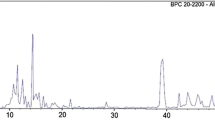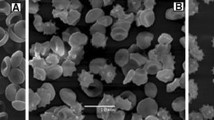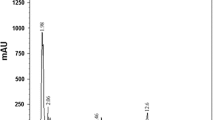Abstract
The antioxidant activity of several plant catechol derivatives was tested in buffer, plasma, and human erythrocytes. In buffer, chlorogenic acid (CGA), caffeic acid (CA), and dihydrocaffeic acid (DCA) reduced ferric iron equally well in the ferric reducing antioxidant power (FRAP) assay. Low concentrations of the polyphenols enhanced the ability of plasma to reduce ferric iron by about 10%. In plasma, lipid hydroperoxide and F2-isoprostane formation induced by a water-soluble free radical initiator were reduced by CGA at concentrations as low as 20 μM. During incubation at 37°C, human erythrocytes took up DCA, but not CGA, and intracellular DCA enhanced the ability of erythrocytes to reduce extracellular ferricyanide. When intact erythrocytes were exposed to oxidant stress generated by liposomes containing small amounts of lipid hydroperoxides, extracellular CGA at a concentration of 5 μM decreased both lipid peroxidation in the liposomes, and spared α-tocopherol in erythrocyte membranes. These results suggest that the catechol structure of these compounds convey the antioxidant effect in plasma and in erythrocytes.
Similar content being viewed by others
References
Hollman PCH, Hertog MGL, Katan MB: Role of dietary flavonoids in protection against cancer and coronary heart disease. Biochem Soc Trans 24: 785–789, 1996
Herrmann K: Occurrence and content of hydroxycinnamic and hydroxybenzoic acid compounds in foods. Crit Rev Food Sci Nutr 28: 315–347, 1989
Verschuren WM, Jacobs DR, Bloemberg BP, Kromhout D, Menotti A, Aravanis, C, Blackburn H, Buzina R, Dontas AS, Fidanza F: Serum total cholesterol and long-term coronary heart disease mortality in different cultures. Twenty-five-year follow-up of the seven countries study. J Am Med Assoc 274: 131–136, 1995
Kono Y, Kobayashi K, Tagawa S, Adachi K, Ueda A, Sawa Y, Shibata H: Antioxidant activity of polyphenolics in diets. Rate constants of reactions of chlorogenic acid and caffeic acid with reactive species of oxygen and nitrogen. Biochim Biophys Acta 1335: 335–342, 1997
Goldstein DS, Stull R, Markey SP, Marks ES, Keiser HR: Dihydrocaffeic acid: A common contaminant in the liquid chromatographicelectrochemical measurement of plasma catecholamines in man. J Chromatogr 311: 148–153, 1984
Zhou Y-C, Zheng R-L: Phenolic compounds and an analog as superoxide anion scavengers and antioxidants. Biochem Pharmacol 42: 1177–1179, 1991
Nardini M, D'Aquino M, Tomassi G, Gentili V, Di FM, Scaccini C: Inhibition of human low-density lipoprotein oxidation by caffeic acid and other hydroxycinnamic acid derivatives. Free Radic Biol Med 19: 541–552, 1995
Laranjinha J, Vieira O, Madeira V, Almeida L: Two related phenolic antioxidants with opposite effects on vitamin E content in low density lipoproteins oxidized by ferrylmyoglobin: Consumption vs regeneration. Arch Biochem Biophys 323: 373–381, 1995
Vieira O, Escargueil-Blanc I, Meilhac O, Basile J-P, Laranjinha J, Almeida L, Salvayre R, Nègre-Salvayre A: Effect of dietary phenolic compounds on apoptosis of human cultured endothelial cells induced by oxidized LDL. Br J Pharmacol 123: 565–573, 1998
Nardini M, Natella F, Gentili V, Di FM, Scaccini C: Effect of caffeic acid dietary supplementation on the antioxidant defense system in rat: An in vivo study. Arch Biochem Biophys 342: 157–160, 1997
Waters RE, White LL, May JM: Liposomes containing alpha-tocopherol and ascorbate are protected from an external oxidant stress. Free Radic Res 26: 373–379, 1997
Mendiratta S, Qu Z-C, May JM: Erythrocyte ascorbate recycling: Antioxidant effects in blood. Free Radic Biol Med 24: 789–797, 1998
Shahrzad S, Bitsch I: Determination of some pharmacologically active phenolic acids in juices by high-performance liquid chromatography. J Chromatogr A 741: 223–231, 1996
May JM, Qu Z-C, Mendiratta S: Protection and recycling of α-tocopherol in human erythrocytes by intracellular ascorbic acid. Arch Biochem Biophys 349: 281–289, 1998
Wolff SP: Ferrous ion oxidation in presence of ferric ion indicator xylenol orange for measurement of hydroperoxides. Meth Enzymol 233: 182–189, 1994
Nourooz-Zadeh J, Tajaddini-Sarmadi J, Wolff SP: Measurement of plasma hydroperoxide concentrations by the ferrous oxidation-xylenol orange assay in conjunction with triphenylphosphine. Anal Biochem 220: 403–409, 1994
Avron M, Shavit N: A sensitive and simple method for determination of ferrocyanide. Anal Biochem 6: 549–554, 1963
May JM, Qu ZC, Morrow JD, Cobb CE: Ascorbate-dependent protection of human erythrocytes against oxidant stress generated by extracellular diazobenzene sulfonate. Biochem Pharmacol 60: 47–53, 2000
Orringer EP, Roer ME: An ascorbate-mediated transmembranereducing system of the human erythrocyte. J Clin Invest 63: 53–58, 1979
Benzie IF, Strain JJ: Ferric reducing antioxidant power assay: Direct measure of total antioxidant activity of biological fluids and modified version for simultaneous measurement of total antioxidant power and ascorbic acid concentration. Meth Enzymol 299: 15–27, 1999
Pulido R, Bravo L, Saura-Calixto F: Antioxidant activity of dietary polyphenols as determined by a modified ferric reducing/ antioxidant power assay. J Agric Food Chem 48: 3396–3402, 2000
Morrow JD, Roberts JL II: Mass spectrometry of prostanoids: F2-isoprostanes produced by non-cyclooxygenase free radical-catalyzed mechanism. Meth Enzymol 233: 163–175, 1994
Iwahashi H: Some polyphenols inhibit the formation of pentyl radical and octanoic acid radical in the reaction mixture of linoleic acid hydroperoxide with ferrous ions. Biochem J 346: 265–273, 2000
Morrow JD, Roberts LJ II: Mass spectrometric quantification of F2-isoprostanes in biological fluids and tissues as measure of oxidant stress. Meth Enzymol 300: 3–12, 1999
Székely M, Mαnyai S, Straub FB: Ñber den Mechanismus der osmotischen Hämolyse. Acta Physiol Acad Sci Hung 3: 571–583, 1952
Caccetta RA, Croft KD, Beilin LJ, Puddey IB: Ingestion of red wine significantly increases plasma phenolic acid concentrations but does not acutely affect ex vivo lipoprotein oxidizability. Am J Clin Nutr 71: 67–74, 2000
Deshpande SN, Aguilar AA: Effects of roasting temperatures and gamma irradiation on the content of chlorogenic acid, caffeic acid and soluble carbohydrates of coffee. Int J Appl Radiat Isotopes 26: 656–661, 1975
Author information
Authors and Affiliations
Corresponding author
Rights and permissions
About this article
Cite this article
Lekse, J., Xia, L., Stark, J. et al. Plant catechols prevent lipid peroxidation in human plasma and erythrocytes. Mol Cell Biochem 226, 89–95 (2001). https://doi.org/10.1023/A:1012741903996
Issue Date:
DOI: https://doi.org/10.1023/A:1012741903996




